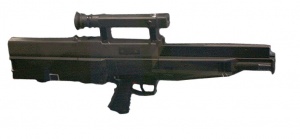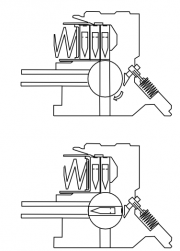Heckler & Koch G11
| Heckler & Koch G11 | |
|---|---|

| |
|
| |
| Type | Assault rifle (G11) Light machine gun (LMG11) Personal defense weapon (G11 PDW) |
| Land of Origin | West Germany |
| Specifications | |
| Length | 750 mm (29.5 in) |
| Barrel length | 540 mm (155 mm per twist) |
| Weight | 3.6 kg (8.0 lb) empty, 4.3 kg (9.5 lb) loaded |
| Cartridge | 4.73x33mm caseless ammunition |
| Action | Gas operated rotary breech, Select fire |
|
| |
| Rate of Fire | |
| Muzzle velocity | ~ 930 m/s (3,050 ft/s) |
| Effective Range | 400m |
| Feed | 45 or 50-rd detachable box magazine |
| Sights | Integrated optical sight |
| Production History | |
| Designer | Heckler & Koch |
| Variants | Assault Rifle Light Machine Gun (LMG11) Personal Defence Weapon (G11 PDW) |
It was primarily a project of West Germany, though it was also of significance to the other NATO countries as well. In particular, versions of the G11 were included in the U.S. Advanced Combat Rifle program.
Contents |
[edit] Design details
The weapon uses a 4.73x33mm caseless ammunition, with the propellant shaped into square blocks. [1] The ammunition is also designated as 4.92 mm because in US Military trials a slightly different version of the G11 was developed, the HK G11 ACR, a groove to groove measurements of the bore was employed, rather than land-land. This was largely because in Germany, bore dimensions are measured land to land whereas in the United States, groove to groove is used.[2] The projectile is 4.93 mm in diameter with a case length of 33mm, the US case length measurement is 34mm since for the ACR trials the chamber length, not the actual case length was used. The 4.73 mm round is half the weight and 40% the size by volume of the 5.56x45mm NATO round used in assault rifles. The round also has similar ballistics to a 5.56 mm round, but the 4.73 mm is much less likely to tumble when hitting or penetrating a target, and thus not as lethal. It is not clear to what extent the round would fragment, which could also make it more lethal. (See terminal ballistics)
The design principle was to increase target hit probability by firing high rate multi-round bursts (Salvos). Tests have been run using a prototype shotgun test-bed called CAWS to see whether a single-shot, multi-projectile system could achieve the range and hit probability requirements. The results indicated that the use of serially fired projectiles at a high rate of fire would achieve the tight shotgun-like pattern with rifle-like accuracy up to the required range.
The weapon itself has three firing modes: semi-auto, full-auto at 460 rounds per minute, and three-round burst at over 2000 cyclic rounds per minute, which is approximately 36 rounds per second. The loading and feed mechanism is physically very complicated but exceptionally fast and reliable. Rounds are fed in to the weapon from a magazine that lies above and parallel with the barrel. The rounds are orientated vertically (at 90 degrees to the bore) and are fed downwards into the rotary chamber so that they can be rotated 90 degrees for firing. The firing cycle process is roughly:
- As the cocking handle on the side is rotated clockwise by the weapon operator:
- A round is dropped into the revolving chamber vertically (a loading piston assists this process).
- The chamber rotates 90° until it is lined up with the barrel. This completes the chambering of the round and cocking of the firing pin.
- When the trigger is pulled, a firing pin ignites the primer, which then ignites a powder booster charge that pushes the bullet into the barrel. The solid block of propellant is broken up to increase the ignition surface area and ignites, accelerating the bullet out of the barrel.
- As the projectile is accelerating up the barrel, recoil forces drive the barrel, magazine, chamber and operating mechanism rearwards within the weapon, dissipating energy for single shot and fully automatic modes but allowing burst mode to deliver three projectiles downrange before buffering occurs.
- Gas tapped off from the barrel rotates the chamber and actuates the loading mechanism then rotating the chamber back to the vertical original position until it is lined up with the feed mechanism and the process repeats.
A conventional assault rifle has approximately eight steps in its cycle:
- Battery: bolt group pushes round from magazine into chamber.
- Lockup: bolt or bolt carrier locks with the barrel extension or receiver.
- Firing: firing pin or striker impacts primer igniting the main propellant charge.
- Unlocking: either through gas, recoil or blow-back operation, the working parts unlock from the barrel extension or receiver.
- Extraction: spent case is extracted and withdrawn from the chamber.
- Ejection: the spent case is thrown clear of the weapon either via a bolt face ejector or from a fixed or semi-fixed ejector.
- Firing mechanism reset: as part of the rearward reciprocation of the working parts, the firing mechanism is reset.
- Buffering: working parts finally strike the buffer and halt. Recoil spring(s) are fully compressed and begin to drive the working parts forward into battery.
|
The recoil in the three-round burst is not felt by the weapon's user until after the third round has left the chamber. This is accomplished by having the barrel and feeding mechanism "float" within the rifle casing. When the rounds are fired, the barrel, magazine, chamber and operating mechanism recoils back against recoil springs several inches. Only when it strikes the buffer at the back of the rifle does the user feel the recoil. During the rearward travel of the internal mechanism the rifle loads and fires 3 rounds. When the barrel and mechanism reaches the rearmost point in its travel, the recoil springs push it forward back into its normal forward position. When firing in semi-auto and full-auto modes, the rifle only loads and fires one round per movement of the internal mechanism. Fully automatic fire is reduced to around 550 rounds per minute.
The internal workings of the rifle were rather complex compared to those of some earlier designs, with the guts being compared to the inside of a compact clock. The number of hours of maintenance required for the G11 as compared to other designs is not clear, especially since the impact of the powder used in the caseless ammo remains unknown. Designers claimed that because there was no ejection cycle the internal mechanisms would have little chance to get exposed to external dust, dirt and sand and this would supposedly reduce the need for cleaning.
There were reports that due to the high tolerances required to seal off the front and rear chamber openings the expected life of the contacting parts was around 6000 rounds before maintenance was required.
[edit] Ammunition cook-off and shape
Premature ignition of ammunition from heat in the chamber, known as cook-off, was a major problem with early prototypes of the G11 where synthetically bound nitrocellulose, formed into blocks, was used. Normally, when a bullet is fed into a chamber its case insulates the propellant from igniting until its impact-sensitive primer is struck by a firing pin or striker. The case aids in insulating the propellant from the heat of the chamber and it takes time for the temperature to rise sufficiently, inside a chambered round, to ignite the propellant. In addition, extracting a hot case removes heat from the system. As a result of doing away with traditional cases, the G11 became a safety hazard and had to be withdrawn from the 1979 NATO trials. The high rate of fire and lack of cartridge cases made cooking-off a significant problem.
To solve this, Heckler and Koch formed a partnership with Dynamit Nobel who redesigned the cartridge to use a new High Ignition Temperature Propellant (HITP). The cook-off problem was reduced, by using a denatured hexogen propellant with a special binder and coating for the ammunition that increased the spontaneous ignition temperature to 100 °C (180 °F) above that of standard, nitrocellulose propellant.
An interesting feature of the new round was its unconventional shape. Most round casings are cylindrical however, the redesigned cartridge was molded into a squared, box-like shape. This allowed the 50-round magazine to carry the maximum amount of propellant in a minimum of space, since the wasted spaces between rounds that accompanies the use of cylindrical cartridges was eliminated.
The issue of heat removal from caseless firing weapons as well as methods of igniting them continues to be researched by other companies. An alternative route was taken by the Austrian company, Voere, which developed a caseless round for the Voere VEC-91 that was electrically fired. This technique makes it possible to greatly increase the ignition temperature of the ammunition, while maintaining the ability to fire it. This would increase the maximum rate and duration a gun could fire at before cooking off rounds, but the VEC-91 never took advantage of this, since it was a bolt-action rifle. As yet, the only weapon that electrically fires caseless ammunition automatically is Metal Storm.
[edit] Variants
According to various web sites, there was the LMG11 squad-level automatic weapon and the G11 PDW personal defense weapon planned on the same ammunition family as that used by the G11. Some hints of the former caseless PDW design can be seen in the current Heckler & Koch MP7 personal defense weapon. One of the most important reasons as for the creation of the new weapon and the new munition was the issue of weight: the M16A2 with a total of 270 cartridges weighs about 16 lb (7 kg), while a shooter with the G11K2 rifle would be able to carry 600 rounds of ammunition at the same weight. Another design feature of the rifle was the ability to mount three 45-round magazines on rails on the front of the rifle, making reloading much faster. Additionally, a factory-zeroed scope would give the shooter an advantage over an adversary using a rifle with iron sights, though the modern trend is towards integrated scope rails for greater versatility.
[edit] Future
In 1990, H&K finished the development of the G11, intended for the Bundeswehr and other NATO partners. Although the weapon was a technical success, it never entered full production due to the political changes of German reunification and lack of procurement contract.[3] Only 1000 units were ever produced, some of which made their way into the hands of the Bundeswehr.
By 2004, the technology developed for the G11 was licensed for the Lightweight Small Arms Technologies project[4], the current project of which is a light machine gun prototype for the US Army. The design is intended to be able to proceed with either a cased cartridge using a composite case or a caseless ammunition design developed from the G11. Both ammunition designs are telescoped ammunition like that used by the G11, however the current ammunition design has a plastic case in contrast to the fully caseless G11 ammunition. The design, like the G11, uses a rotating bolt, but rotating about the longitudinal axis of the weapon.
[edit] Resources

This article has no links to any manuals whatsoever! This article needs more input to fill in those missing bits. You (yes, you!) can help Gunsopedia provide more comprehensive information to our users by submitting a manual that you might have. See this page to find out how you can contribute a manual to the Gun Owners' Resource Online Library and help your fellow gun owners. With your help, we really can make this a one-stop resource for all gun owners!
[edit] See also
- Armtech C30R
- Gerasimenko VAG-73
- Gyrojet
- Voere VEC-91
- Steyr ACR
- Benelli CB M2
- Heckler & Koch G36
- Lightweight Small Arms Technologies
[edit] References
[edit] External links
| This article is part of a series on Heckler & Koch firearms | ||
|---|---|---|
| Handguns | HK4 · VP70 · P9 · P7 · Mark 23 · USP · P2000 · P30 · HK45 |  |
| Military Semi-auto & Select-fire Rifles | G3 · HK33 · PSG1 · G41 · G36 · HK416 · HK417 | |
| Civilian Rifles | HK41 · HK43 · SL6 · SL7 · SL8 · SR9 | |
| Shotguns | FABARM FP6 | |
| Submachine guns | MP5 (duh!) · UMP · MP7 | |
| Machine guns | HK21 · MG4 | |
| Grenade launchers | HK69A1 · AG-C/GLM · AG36 · M320 · GMG | |
| Prototypes | Handguns — P46 Rifles — HK32· HK36· G11· XM29 OICW· XM8 Shotguns — HK CAWS | |
| Other Stuff | P2A1 · P11 · 4.6x30mm | |
| Heckler & Koch G11 is part of a series on Weird guns | ||
|---|---|---|
| Rifles | Heckler & Koch G11 | CornerShot | Periscope rifle | Krummlauf | 
|
| Shotguns | Pancor Jackhammer | |
| Pistols | Duck's foot | Protector Palm | AF 2011 | |
| Revolvers | Chiappa Rhino | Apache Revolver | |
| Others | AO-46 PDW | Harmonica gun | |





